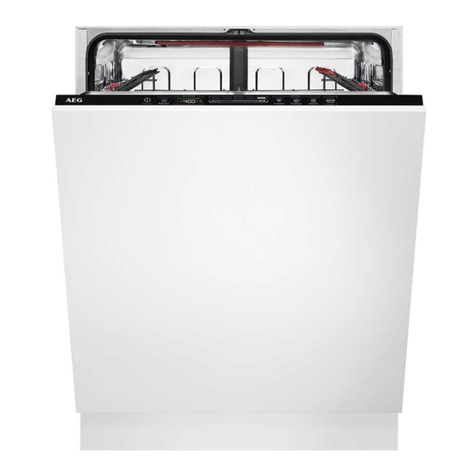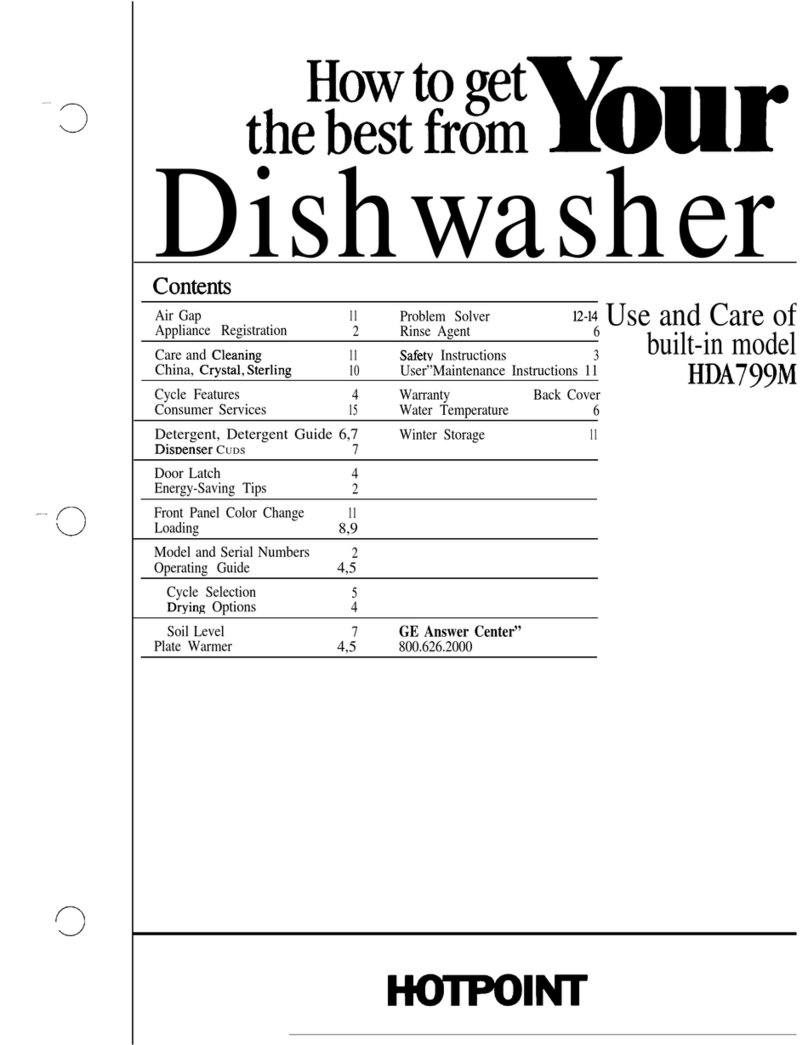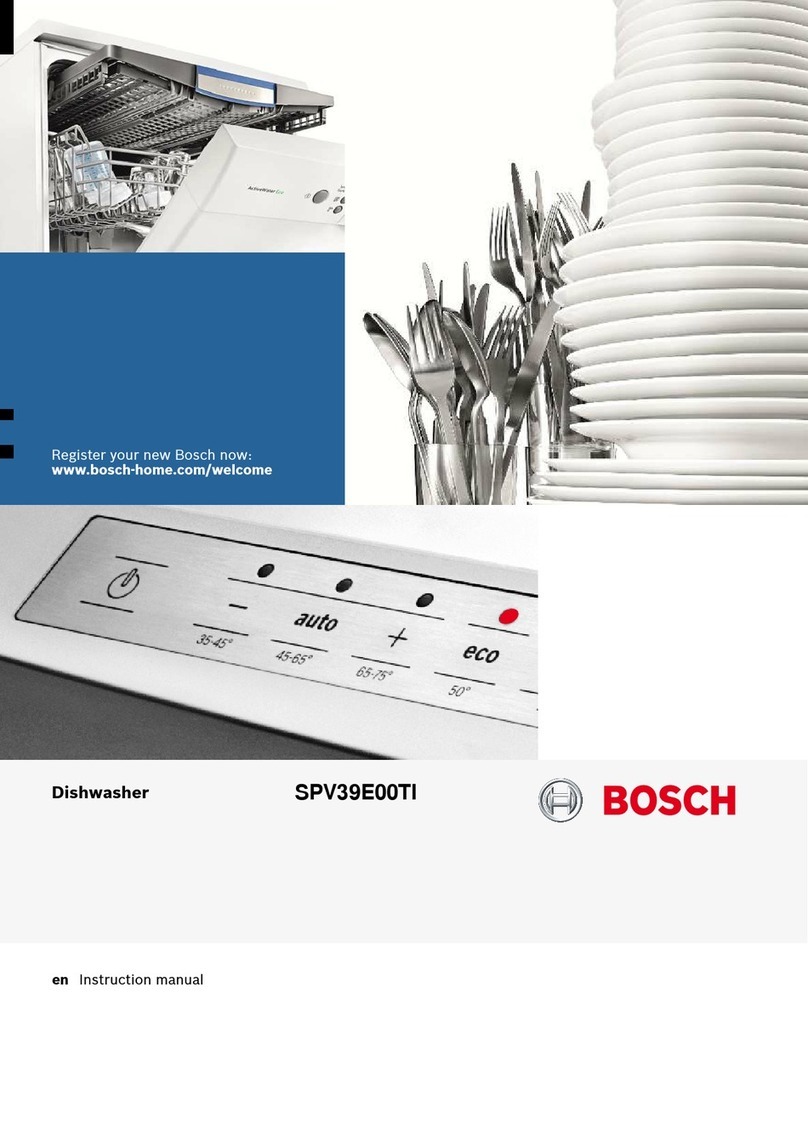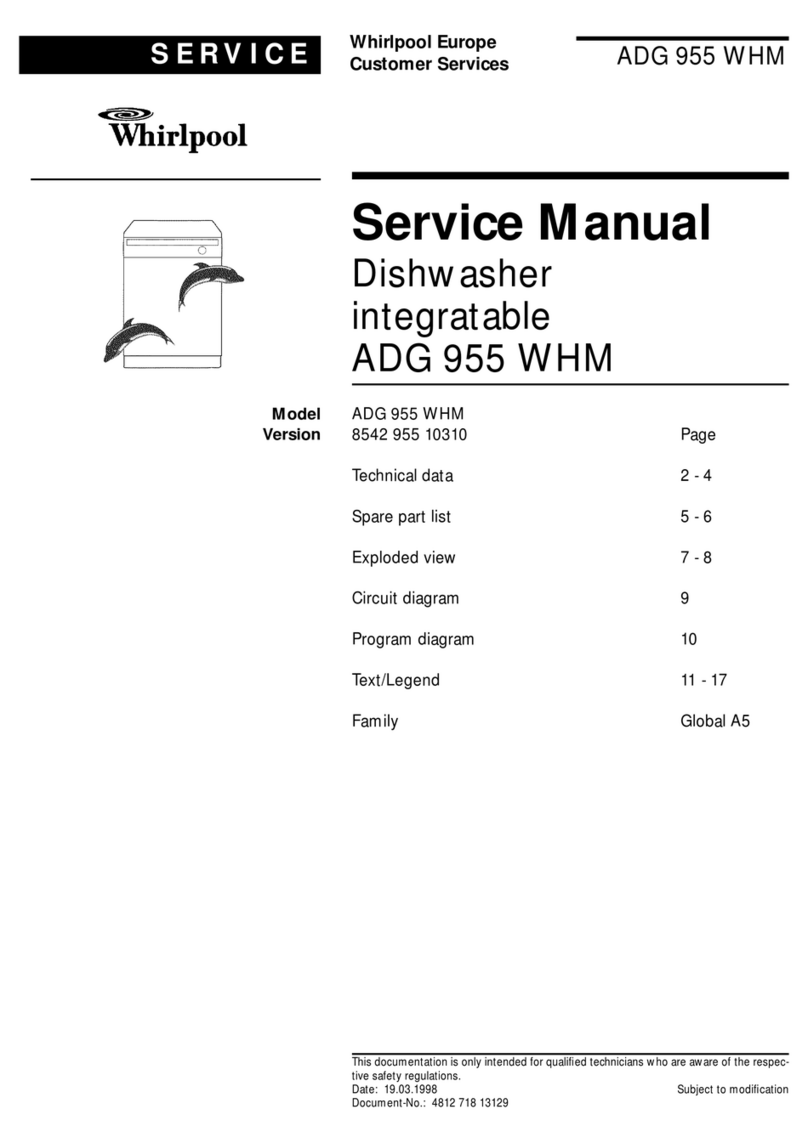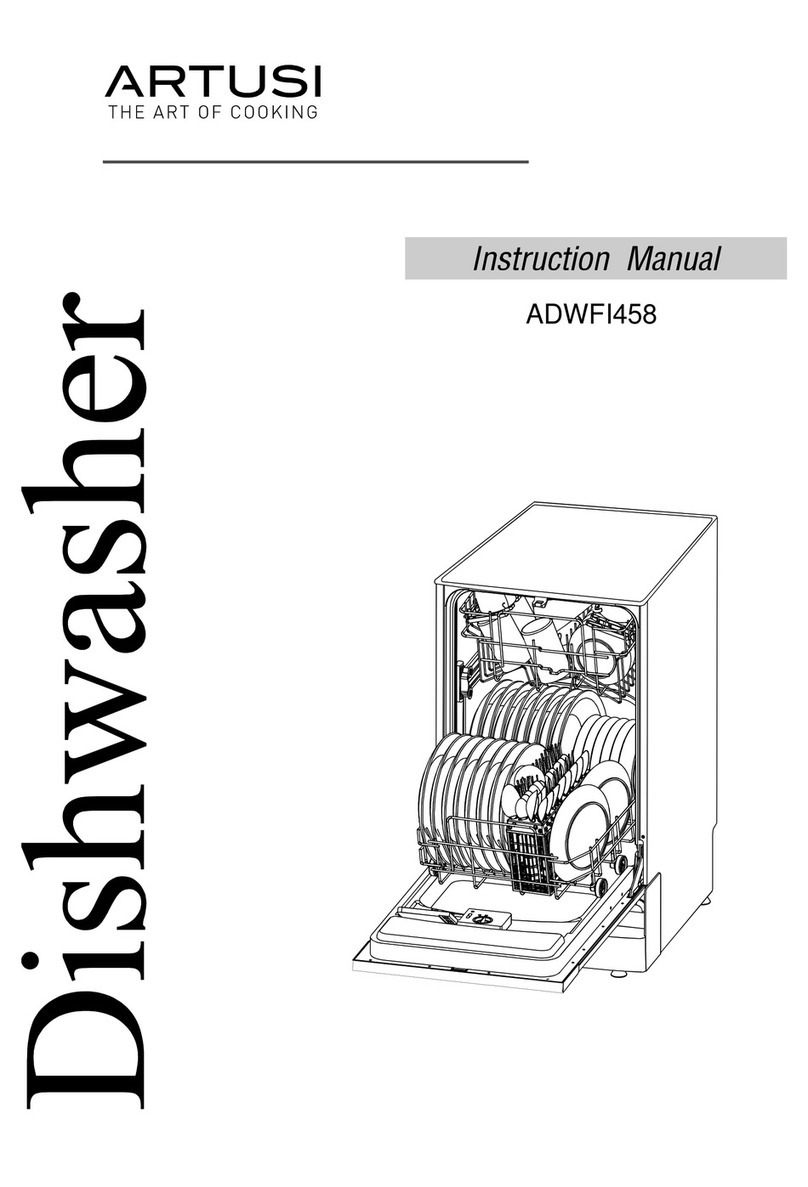ElcoBrandt ATLANTIS Installation guide

The ATLANTIS
Dishwashe
r
Brandt Customer Services
TRAINING
TECHNICAL
wsh
A
C
C
H
H
SET


THE ATLANTIS DISHWASHER
Technical Training
CONTENTS
- 3 -
LA3-
A
TLANTIS-002U
K
-04/04
1 - INTRODUCTION ......................................................................................................................................................5
2 - THE ENERGY LABEL..............................................................................................................................................7
2.1. - What you must know.........................................................................................................................................7
2.2. - Consumption level of the main appliances*......................................................................................................7
3 - THE DISHWASHER .................................................................................................................................................8
3.1. - The customer's expectations ............................................................................................................................8
3.2. - The advantages of the dishwasher...................................................................................................................8
3.3. - The sound level.................................................................................................................................................8
3.4. - The drying .........................................................................................................................................................8
3.5. - Operating principle............................................................................................................................................9
4 - THE WATER...........................................................................................................................................................10
4.1. - The noxious effects of limestone ....................................................................................................................10
4.2. - The effects of too soft a water ........................................................................................................................10
4.3. - The water softening : a vital function ..............................................................................................................11
4.4. - The regeneration.............................................................................................................................................11
4.5. - The pH (hydrogen potential) ...........................................................................................................................12
5 - THE DETERGENTS ...............................................................................................................................................13
5.1. - The products ...................................................................................................................................................13
6 - THE ATLANTIS DISWASHER ...............................................................................................................................14
6.1. - Presentation ....................................................................................................................................................14
6.2. - Identification of the reference .........................................................................................................................16
6.3. - Fitting ..............................................................................................................................................................17
6.4. - Adjusting the water softener ...........................................................................................................................18
6.5. - Setting of the rinsing agent dispenser ............................................................................................................19
6.6. - Use of the sensors in new wash recipes classified A A A ..............................................................................20
6.7. - Other possibilities offered by the electronics ..................................................................................................21
6.8. - Intuitive internal arrangement .........................................................................................................................21
6.9. - Low sound level ..............................................................................................................................................21
6.10. - Filtering 100% efficient throughout the cycle and easy to access..................................................................21
6.11. - Hydraulic diagram ...........................................................................................................................................22
6.12. - The filling of the Atlantis dishwasher with flow meter .....................................................................................23
6.13. - The filling with Atlantis dishwasher without flow meter...................................................................................23
6.14. - The "floating" regeneration .............................................................................................................................25
6.15. - The drying .......................................................................................................................................................26
6.16. - The different components ...............................................................................................................................28
6.17. - The washing programmes ..............................................................................................................................36
6.18. - Synoptic ..........................................................................................................................................................39
6.19. - The block diagram of the Atlantis dishwasher with electronic access ............................................................40
6.20. - The block diagram of the Atlantis dishwasher with mechanic access without flow meter..............................41
7 - OPERATION SERVICE..........................................................................................................................................42
7.1. - The diagnosis assistance programme (DAP) .................................................................................................42
7.2. - Checks and measurements possible at power board terminal strips .............................................................44
7.3. - The electronics-controlled safety devices.......................................................................................................47
7.4. - Water height in tank from pressure controller switching.................................................................................48


THE ATLANTIS DISHWASHER
Technical Training
INTRODUCTION
- 5 -
LA3-
A
TLANTIS-002U
K
-04/04
1 - INTRODUCTION
The objective is simple : the matter is to make the dirty dishes clean. The quantity, nature, dirt level of
the dishes, the cleaning product used, or even the water hardness may act against the expected result.
So far, all these parameters have been left to the assessment of the consumer, who alone assumed
the responsibility for poor wash. Increasingly, the new ATLANTIS dishwasher consider all these
factors.
The intelligent use of some sensors enables the electronics to adapt the run of its auto-programs,
in order to guarantee the result while trying to save water, energy and time, and this, whatever the load
or dirt rate is.
The new ATLANTIS dishwasher provides reduction in water, energy consumption, and cycle times
while assuring A level in washing and drying.
To perform the dishwasher maintenance, the technician has to identify the cause(s) at the origin of the
consumer's claim. To do so, he has to make a precise diagnostic in order to adopt the appropriate for
the encountered problem.
The new ATLANTIS dishwasher proposes a programme of aid to diagnostic intended for the
after-sales department. Only the rigorous and systematic implementation of this programme can
definitely assure the action reliability.
A properly performed after-sales action should favour the development of customer’s loyalty to the
sales outlet, to the sign and also to the trademark concerned.


THE ATLANTIS DISHWASHER
Technical Training
ENERGY
- 7 -
LA3-
A
TLANTIS-002U
K
-04/04
2 - THE ENERGY LABEL
2.1. - What you must know
Washing machine, dryer and dishwasher are three
appliances likely to weigh heavy on the electricity invoice if
you choose model poorly classified from the energetic
point of view. Washing machine and dishwasher each
consume about 250 kWh a year. For a few years, the
manufacturers have made efforts on the water
consumption, which has a direct effect on the power
consumption at the moment of the heating.
Initiated by the European Community, this labelling is now
compulsory in France for most household electrical
appliances. The classification from A(the most
economical) to G(the most avid on electricity), enables the
consumer to locate at a glance, the various models
proposed.
For washing machines, an additional indication concerning
the wash and spin, complements the information
concerning the power consumed.
This mention must appear compulsorily on all the
dishwashers marketed from the 1st of January 2000.
The “Bio” programme is selected to laboratory tests.
2.2. - Consumption level of the main appliances*
Dryer (150 uses)
Electric hob
Dishwasher (220 uses)
Chest freezer
Electrical oven
Washing machine (200 uses)
Refrigerator
Television
Microwave oven 800W
Iron
Vacuum cleaner
A good use of the deferred start you to benefit by off-peak periods
and, therefore, to save electricity.
Dishwasher
Energy
Manufacturer
Model
More efficient
Less efficient
Washing performance
(dB(A) re 1 pW)
Noise
Further information is contained
in product brochures
Norm EN 60456
LOGO
Energy consumption
Actual energy consumption will
depend on how the appliance is used
kWh/cycle
A: higher G: lower
Capacity (place settings)
Water consumption
1 2 3A B C
Dishwasher label Directive
Drying performance
A: higher G: lower
(In accordance with programme
recomanded by the manufacturer)

THE ATLANTIS DISHWASHER
Technical Training
THE DISHWASHER
- 8 -
LA3-
A
TLANTIS-002U
K
-04/04
3 - THE DISHWASHER
3.1. - The customer's expectations
• Perfectly clean dishes
• Dry dishes
• Sparkle of glasses and stainless steel
• Respect of delicate dishes
• Rapidity
• Easy to use
• Low sound level
• Low consumption (water, electricity and products)
3.2. - The advantages of the dishwasher
A family of four persons devotes 55 minutes a day on average to do dishes, against 20 minutes when
it has a dishwasher.
The cost of a dishwasher is written off in only 3 years and its estimated lifetime is approximately 10 years.
Washing up in machine is much more hygienic because dishes are perfectly washed and dried
without contact with external elements (towels, hands or work surface), which often convey a number
of bacterias.
ATLANTIS 0,25 €
€€
€
DISHES DONE BY AND 0,88 €
€€
€
Water (12 litres) 0,03 €Water (70 litres) 0,18 €
Energy (0.75 kWh) 0,08 €Energy (4,8 kWh) 0,53 €
Detergent product 0,10 €Detergent 0,14 €
Rinsing product 0,01 €Accessories 0,03 €
Salt 0,03 €
Annual cost 91,25 €
€€
€Annual cost 321,20 €
€€
€
3.3. - The sound level
Noise remains a selection criterion essential despite the fact that indicating it on the "Energy Label" is
not compulsory.
For the ATLANTIS dishwasher, the level is comprised between 45 and 51 decibels (dB). It must be
known that a variation by 3 decibels multiplies by two the sound volume and this is only below 50
decibels that the dishwasher can be operated late at night.
To achieve this result, several improvements have been made to the ATLANTIS dishwasher :
• PTC and double auxiliary winding for certain asynchronous cycling pumps
• Reinforced acoustics (double-thickness bitumen, felts, phonic seals)
• Passage of the entire spraying circuit in the tank.
3.4. - The drying
The drying result is an important point that appears on the "Energy Label".
The ATLANTIS dishwasher proposes 3 marks for the drying (A/B/C), according to the dishwasher level
of equipment.

THE ATLANTIS DISHWASHER
Technical Training
THE DISHWASHER
- 9 -
LA3-
A
TLANTIS-002U
K
-04/04
3.5. - Operating principle
Dirt adheres to dishes with a certain energy that is to be overcome to get rid of it. It is, therefore,
necessary to implement the following actions:
The mechanical action (aspersion)
Its purpose is to project the detergent bath onto dishes to remove and drag the dirt.
The ATLANTIS dishwasher is provided with 4 spraying levels:
• Two that spray the lower and upper baskets
• A third one, multidirectional (small shower) attached to the tank ceiling prevents residues from
depositing on the tank ceiling and falling during drying
• A fourth one, carried out using a rotary nozzle assembled to the lower winch in certain models, is
used to better clean the bottom of saucepans (it is associated to a specific program).
Spraying the dishes is performed by the winches, which turn simultaneously or not (alternate spraying)
under action of the water pressure in spraying nozzles. The water thus projected onto dishes falls in
the tank bottom where it is purified by flowing through four filters. These filters perform continuous
recycling of the detergent solution until cycle end.
The water is then returned, pressurised, by the circulation pump (approximately 50 litres / minute) into
the spraying arms. Such a circulation and the low volume of the cycling unit volume (1.85 litres) are
used to have a total water consumption relatively low (12 litres), as each piece of dishes is washed by
only one volume of water (approximately 4 litres).
After wash, the wastewater is evacuated, the clear water, cold for the first rinse rinses dishes, and
then a second rinse, hot, precedes the drying.
The thermal action
The progressive temperature rise and the achievement of an enzymatic dwell at 50°C are used to
obtain the best conditions of elimination of all the types of dirt. Actually, the action of the various
components of detergent products varies according to the bath temperature.
The chemical action
When dishes are done in machine, the mechanical action is limited (as compared with dishes done by
hand), and must therefore be compensated for by a more powerful chemical action.
To the mechanical and thermal energy of the machine are added the physical-chemical and biological
actions of the detergent.
As the nature of dirt is very varied, it is not always eliminated in the same way.
This is the reason why detergents contain very different components and, in particular, enzymes.
The duration.
All is not as simple. If we detail the operation, we remark that an essential element is missing : the
water. Actually, without water, there is no wash! The water will, with the support of active principles of
the detergent, destroy, eradicate, dissolve and emulsify the dirt present on dishes.
It will do so all the better since the machine will water the dishes and heat the water.
The wash result depends, therefore, simultaneously on 4 factors :
• The washing product
• The water
• The temperature
• The mechanics
A good wash result can, therefore, only be obtained if all these conditions are respected.
Spraying arms project onto dishes (mechanical action) a solution of detergent
products (chemical action) progressively heated by a resistor (thermal action)

THE ATLANTIS DISHWASHER
Technical Training
THE WATER
- 10 -
LA3-
A
TLANTIS-002U
K
-04/04
4 - THE WATER
The water covers, in the nature, a cycle due to its continuous evaporation under the action of the sun
heat; this vapour is condensed into fine droplets to produce clouds, which are transformed into rain
when they meet a cold air draft.
It is possible to assert practically that this is from the moment where the rain starts falling that it begins
to lose its purity. Actually, during its fall, the rain meets in the atmosphere a certain number of
impurities of variable nature, among which carbon gas with which it is combined to make up very
slightly acid soft water.
This water, when it arrives on earth, flows by streaming and infiltrates the cracks to reach the
groundwater tables and artesian tables that feed sources and wells. In both cases, this water dissolves
and carries with it a part of the mineral salts it meets (limestone, magnesium, etc.); this is this last
process, which causes its mineralisation. The more the water is mineralised, the harder it is !
The water hardness is expressed in degrees TH.
1 French degree TH corresponds to 10 mg of CO3 Ca per litre of water.
from 0° to 5° TH very soft water
from 5° to 15° TH soft water
from 15° to 30° TH half-hard water
from 30° to 45° TH hard water
More than 45° TH very hard water
4.1. - The noxious effects of limestone
Any water contains traces of minerals, mainly limestone, magnesium and iron originating from the
ground. The higher the content is, the harder the water is. These minerals reinforce the dirt catch to
fabric fibres, and the eliminated one tends to be fastened again to them. Limestone reduces the
efficiency of the washing product, makes the laundry rough, makes whites turn grey, fades colours and
accelerates the laundry wear.
4.2. - The effects of too soft a water
Too soft a water also reduces the washing efficiency (reduction in mechanical action), causes foam
overflows, leaks and accelerates the appliance ageing (the water is more aggressive).

THE ATLANTIS DISHWASHER
Technical Training
THE WATER
- 11 -
LA3-
A
TLANTIS-002U
K
-04/04
4.3. - The water softening : a vital function
The system water contains soluble calcium hydrogen carbonate. Hot, the calcium hydrogen carbonate
decomposes and gives insoluble calcium carbonate (fur).
The water softening is, therefore, a vital function.
This is the reason why all dishwashers are fitted, from the origin, with water softeners.
Softening is, in fact, the substitution of calcium ions contained in the system water by sodium ions
contained in the salt.
To perform this substitution, the water is circulated in the heart of the softener that contains small
balls of synthetic resin.
Combined with sodium, this resin sets the limestone particles (calcium or magnesium) contained in
the system water. To do so, the resin exchanges its sodium ions for the calcium ions.
After a certain number of fillings, resins are more or less saturated with limestone and start becoming
ineffective to soften the water. It is then necessary to regenerate them.
4.4. - The regeneration
To regenerate the resins, it is necessary to eliminate the limestone from them with sodium (salt).
This regeneration, automatic and "floating" on "all electronic" ATLANTIS dishwashers, is initiated by
the board according to the adjustment performed on the putting into service and to the number of filling
baths already performed.
SOFTENER
Resin
Water
+
Calcium &
magnesium
Softened
water
+
sodium
Saturated resin
Water
+
Calcium (Ca)
and
magnesium
SALT
Water WATER
+
S
ALT
W
ate
r+
Ca

THE ATLANTIS DISHWASHER
Technical Training
THE WATER
- 12 -
LA3-
A
TLANTIS-002U
K
-04/04
4.5. - The pH (hydrogen potential)
Maybe, you have already remarked on labels of cleaning products or drinks the pH indication followed
by a number. Maybe, you know that the pH is related to the acidity of a solution, sometimes verifiable
by its taste. If you taste successively lemon juice, coffee and water, you will be able without any
difficulty to rank these three liquids by level of acidity.
10141312111098765432
Acid Neutral Basic
Chlorydric acid
Coca-cola
Vinegar
Beer
Milk
Sea water
Concentrated
Bleach
Sink caustic
cleaner
Tape water
The pH paper is used for approximate, simple and rapid determination of the pH of a solution.
This paper, which does not provide exact determination of a value of pH, rather gives an idea of the
pH range of the solution, namely:
• Acid for a pH smaller than 7
• Neutral for a pH equal to 7
• Basic or alkaline for a pH greater than 7
Water, mineralised or not (and, therefore, salt water) has a pH very close to 7.
A few acids
• Vinegar (acetic acid)
• Aspirin (acetylsalicylic acid)
• Lemon juice (citric acid)
• Coffee
• Vitamin C (ascorbic acid)
• Dishwasher rinsing product
A few bases
• Household cleaning products (ammonia)
• Soap (potassium hydroxide)
• Concentrated bleach
• Sink caustic cleaner (sodium hydroxide)
• Detergent products for washing machine and dishwasher
Alkaline pH is necessary for the washing bath to ensure maximum efficiency.
4.5.1. - Analysis of traces or deposits on dishes
Replacing a component supposed defective does not constitute the essentials of the maintenance of
a dishwasher. A dishwasher, for which the consumer signals a bad wash result, cannot be repaired so
easily. Actually, to solve this type of claim, it will always be necessary to precisely identify the nature
of the trace or residue present on the piece of dishes. Only this precise identification can indicate us
the probable cause at the origin of the defect.
The matter is not to precisely measure the pH but simply to detect the origin of the white traces or of
the residues.
So, when the paper turns red we are in the presence of an acid solution (rinsing product for example),
if it turns blue, then it is an alkaline solution (washing product).
Red Blue
Green

THE ATLANTIS DISHWASHER
Technical Training
THE DETERGENTS
- 13 -
LA3-
A
TLANTIS-002U
K
-04/04
5 - THE DETERGENTS
5.1. - The products
5.1.1. - The detergents
Contrary to many received ideas, all detergents are not identical. They contain specific ingredients.
So each type of detergent has its own features and will be particularly suited to such or such type of
wash or of dishes.
• Detergent products are alkaline.
• They have, therefore, a pH comprised between 9 and 11.
• They are classified IRRITATING.
The powder
It is perfectly efficient under difficult wash conditions (very hard water or very dirty dishes) and is
suitable for washing silver and decorated glasses.
The tabs
The dosage ease certainly explains the development of their market share. The dissolution time can
vary from 10 seconds to over 10 minutes. When selecting a fast or short program, it's better to use
powder.
The liquids
It is particularly more suitable for fragile dishes and respects the decoration.
5.1.2. - The rinsing product
It enables water to flow more rapidly and more completely from dishes, so preventing the formation of
traces during drying. It neutralises alkaline residues of the detergent during the final rinse and favours
the drying of dishes. Its acid pH is comprised between 1 and 3. It must be compatible with the
detergent (it is preferable to keep the same product trademark).
5.1.3. - The regenerating salt
It is used to regularly regenerate the water softener resins. It protects the appliance and dishes from
layers of sediment. Its pH is neutral and equal to 7.
5.1.4. - The "all-in-one" products
New products integrate in one and the same dose the 3 functions essential to the right operation of
the dishwasher:
• The wash function
• The salt function
• The rinse function
In cases of hard and very hard water (hardness greater than 35°TH), it is indispensable to use
regenerating salt. Some manufacturers specify that the wash must be done at 50°C maximum under
penalty of freeing too early the various actions of the product and altering the final result, or even
damaging some pieces of dishes.

THE ATLANTIS DISHWASHER
Technical Training
THE RANGE
- 14 -
LA3-
A
TLANTIS-002U
K
-04/04
6 - THE ATLANTIS DISWASHER
6.1. - Presentation
The ATLANTIS frame proposes a large choice of models: free-standing with rounded design or flat
design with frame decor, or built-in and also many options (alternate spraying, saucepan nozzle,
insulation, fan, condenser, turbidimeter, mezzanines …).
5 levels of electronics exist, defined by the type of access :
3 ‘all electronic’ models, from L0 to L3, and 1 ‘mechanical access’ model, Lm.
Lm
Mechanical access
• Salt light
• Rinsing light
• Washing light
• End of programme light
• Start/Cancel button
• Programmes Knob
L0
Multi-LED display
wshA
C
C
3
hwshA
6
h
• Delayed start button
• Programme buttons
• Start/Cancel button
• Salt light
• Rinsing light
• On/Off button

THE ATLANTIS DISHWASHER
Technical Training
THE RANGE
- 15 -
LA3-
A
TLANTIS-002U
K
-04/04
L1
Display 2 digits
wshA
C
• On/Off button
• Salt light
• Rinsing light
• Programme buttons
• Display
• Delayed start
• Start/Cancel button
L2
Display 2 digits
or
Display 3 digits
(clock)
wshA
C
wshA
C
• On/Off button
• Salt light
• Rinsing light
• Programme buttons
• Display
• Delayed finish
• Start/Cancel button
L3
LCD display
46,6 Axe Bouton
wsh
A
C
C
H
H
SET
• On/Off button
• Programme buttons
• Display LCD
• Delayed finish
• Start/Cancel button

THE ATLANTIS DISHWASHER
Technical Training
IDENTIFICATION
- 16 -
LA3-
A
TLANTIS-002U
K
-04/04
6.2. - Identification of the reference
The identification plate is on the right hand side of the double door.
Interpretation of the factory reference :
FACTORY
REFERENCE REMARK
1ist characteristic Chassis
A ATLANTIS
2nd characteristic Type of installation
A / B / C Free-standing with entasis
E Not cabinet
F Cabinet
G Cabinet & Cooker top
H Not cabinet & Cooker top
I
Free standing
Cabinet & raised element
K Cabinet & raised element
L
M
Can be encased Not cabinet & raised element
O Integrate model raised element
Q Fully integrated model raised element
3rd characteristic Level
0 L0 Display Leds
1 L1 Display 2 digits
2 Display 3 digits
3 L2 Display 4 digits
4 L3 Display LCD
8 or 9 Lm Buttons and/or Programmes knob
4th characteristic Equipment
A With dirt sensor
B
- With flap-valve (alternated spaying)
– Air drying Without dirt sensor
F With dirt sensor
G
- With flap-valve (alternated spaying)
– Drying by condensation Without dirt sensor
H - Without flap-valve
- Drying by condensation Without dirt sensor
L - With flap-valve (alternated spaying)
– Natural drying Without dirt sensor
M - Without flap-valve
- Natural drying With dirt sensor
5th and 6th
characteristic Brandt code
7th and 8th
characteristic Country code
9th characteristic Index
Trademark
Serial number :
- Year
- Week
- Number of order
Commercial reference
Factory reference

THE ATLANTIS DISHWASHER
Technical Training
FITTING
- 17 -
LA3-
A
TLANTIS-002U
K
-04/04
6.3. - Fitting
6.3.1. - Levelling by adjusting the feet
The dishwasher must be well balanced ad stable. The four feet can
be adjusted, so adjust them if the necessary using a screwdriver. If
the feet are poorly adjusted, this decentres the door and makes the
dishwasher wobble, causing leaks. For dishwashers that can be
built-in, fitted with rear feet adjustment via two knurled knobs on the
base of the machine, at the front, use a screwdriver.
For better noise insulation, install the flap supplied with the
dishwasher.
6.3.2. - Water connections
Lenght of the water supply pipe : 1.50m
Flow : 10l/min. minimum
Tap : with threaded end, 20/27mm
Pressure : 1 bar to 10 bars
Connecting the hot water : Check that the original hose is designed for
connection to the hot water supply.
6.3.3. - Electrical connection
• Mains voltage : 220-240V
• Fuse : 10A, 13A or 16A
The socket outlet must be grounded to earth. The machine must be installed so that the socket
remains accessible. Do not use an electrical extension, a double socket or an electrical timer.
The installation must comply with the country’s prevailing norms.
6.3.4. - Draining away the waste water
Connect the drain hose :
• To a ventilated siphon
• To a sink U-bend
• Directly to a sink
6.3.5. - Built-in unit and faceable units
• Remove the top board
• Adjust the height of the feet, if necessary
• Fix the dishwasher to the worktop
• Cut a laminated panel to the following dimensions (in mm) 595 x 585 with a maximum thickness
of 4mm.
• Adjust the tension on the springs, if required
6.3.6. - Dishwasher with built-in hob
The dishwasher combines two functions, which means that it must be connected to the wall so that it is
completely safe to use. This is to prevent a child, who may accidentally lean on the door while the
loading or unloading the dishes , from causing a hot (boiling) pan resting on the hob to fall, resulting in
severe burns or scads. It is essential that these instructions be observed.
Remove the
stopper form the
U
-
bend

THE ATLANTIS DISHWASHER
Technical Training
FITTING
- 18 -
LA3-
A
TLANTIS-002U
K
-04/04
6.4. - Adjusting the water softener
Measuring the water hardness
After checking the hardness of the water from the tap,
either with the help of the small strip provided with the
appliance, or with the AQUA-TEST, adjust the
softener on the position which corresponds to the
degree of hardness you have measured. It is very
important to respect the setting recommended, as
follows :
Water which is insufficiently softened (> 15° F) will
leave traces of lime on the glasses.
Water which is too well softened (< 5° F) could bring
about an irreversible opalescence of the glassware.
Testing strip Water
hardness Setting Salt
required
0 à 10°TH 0 No
10 à 18°TH 1 Yes
18 à 25°TH 1 Yes
25 à 40°TH 2 Yes
40 à 55°TH 3 Yes
55 à 70°TH 4 Yes
> à 70°TH 5 Yes
Setting on the control panel (L0, L1, L2 and L3)
Using the keys of the control panel following the explanatory notes in the appliance's Instructions for use.
On these models, the distributor's cursor is held at position 4 and the regeneration does not occur with
each cycle, but sequentially, when the resins are saturated.
The microprocessor counts and holds in memory the number of fillings carried out, and according to the
hardness programmed when the setting was effected, it sets off a regeneration at the appropriate time.
The adjustment of the hardness is done with the help of a combination of keys (see Instructions).
The visualisation of the adjustment, depending on the model, is done
• either with the help of the programme indicator lights,
• with the digital display.
When the machine is first switched on, the setting is 10-25°F.
• the display shows d1
• the “drenching” light permanently lit
For water which is extremely hard (> 70°F), you need to replace the cursor to regulate
the softener on the MAXI position (number 5).
Adjustment via the cursor inside the tub (Nm)
The setting of the softener is done by a cursor which is found inside the tub, on
the left hand side.
2
3 4
1

THE ATLANTIS DISHWASHER
Technical Training
FITTING
- 19 -
LA3-
A
TLANTIS-002U
K
-04/04
Filling the regenerating salt reservoir
In order for the softener to work correctly, when the machine is first put to use the salt container
should be filled with water (after the regenerative salt has been poured in). Be sure to screw the salt
container's lid down securely. Failure in doing this or in screwing it properly on its threads will result in
an abnormal consumption of salt and traces of salt on the dishes.
6.5. - Setting of the rinsing agent dispenser
Fill the rinsing agent dispenser, pouring in at least the whole of the sample provided. This rinsing agent
is essential as it contributes to drying, makes glassware shine more and prevents the formation of
streaks and traces of spots on the dishes.
Hold 120 ml (approximately one glassful).
The dispenser comes with a visual gauge and, depending on the model, with an indicator light
(ballcock controlled by ballcock and ILS).
The original setting is in the middle (Medium position : setting 2).
Do not use
kitchen salt

THE ATLANTIS DISHWASHER
Technical Training
FUNCTION
- 20 -
LA3-
A
TLANTIS-002U
K
-04/04
Cold rinse Rinse +
If excess of foam : R+
Filling duration
cold rinse / hot rinse
6.6. - Use of the sensors in new wash recipes classified A A A
The intelligent use of some sensors enables the electronics to adapt the
run of its auto-programs, in order to guarantee the result while trying to
save water, energy and time, and this, whatever the load or dirt rate is.
A turbidimeter (sensor consisting of an infrared emitter and a phototransistor used to assess the
state assess the state of turbid liquid) is located on the transparent duct of the spraying valve.
It enables the printed circuit board to assess the dirt level from the cycle start. This measurement is
used to optimise the cycle duration (prewash possible or lengthening of the wash duration) and,
therefore, the water consumption, according to the dirt level of dishes.
Cold prewash
Possible correction
Hot washing
Measurement
of dirt level
Hot washing
Measurement
of dirt level
Lengthening of
wash duration
The NTC enables the printed circuit board to estimate the quantity of dishes. Because, this board
measures the water temperature rise at the first cold rinse, and compares it to the water
temperature at the very first filling. This temperature rise, which is due to the heat stored up by
dishes during the previous hot wash, enables the board to know the type of load. This allows to
perform an additional cold rinse in the case of a significant amount of dishes and, therefore, of dirt.
Hot washing Cold Rinse Rinse +
NTC measurement R+ if large amount of dishes
The pressure controller enables the printed circuit board to
know if dirt remains on wash completion, in order to initiate, if
necessary, the additional cold rinse.
Because, if there is much dirt and not enough detergent
during the wash, there is a risk of emulsion, which causes an
excess of dirty foam difficult to evacuate. Draining will then
be incomplete and the time to reach the high level on next
filling will be shorter. The board compares this time to that
recorded during filling for the last hot rinse (that of the
previous cycle is stored in memory).
NTC
47 kΩ
Ω Ω
Ω at 25°C
Table of contents
Popular Dishwasher manuals by other brands
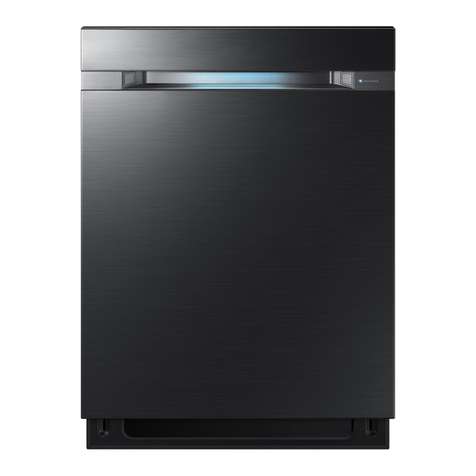
Samsung
Samsung DW80M99 Series user manual

Bauknecht
Bauknecht GSI 5599/1 G Instructions for use

Maytag
Maytag MDB8951BWS - 24 Inch Fully Integrated... Dimensions

Miele
Miele G 5051 operating instructions
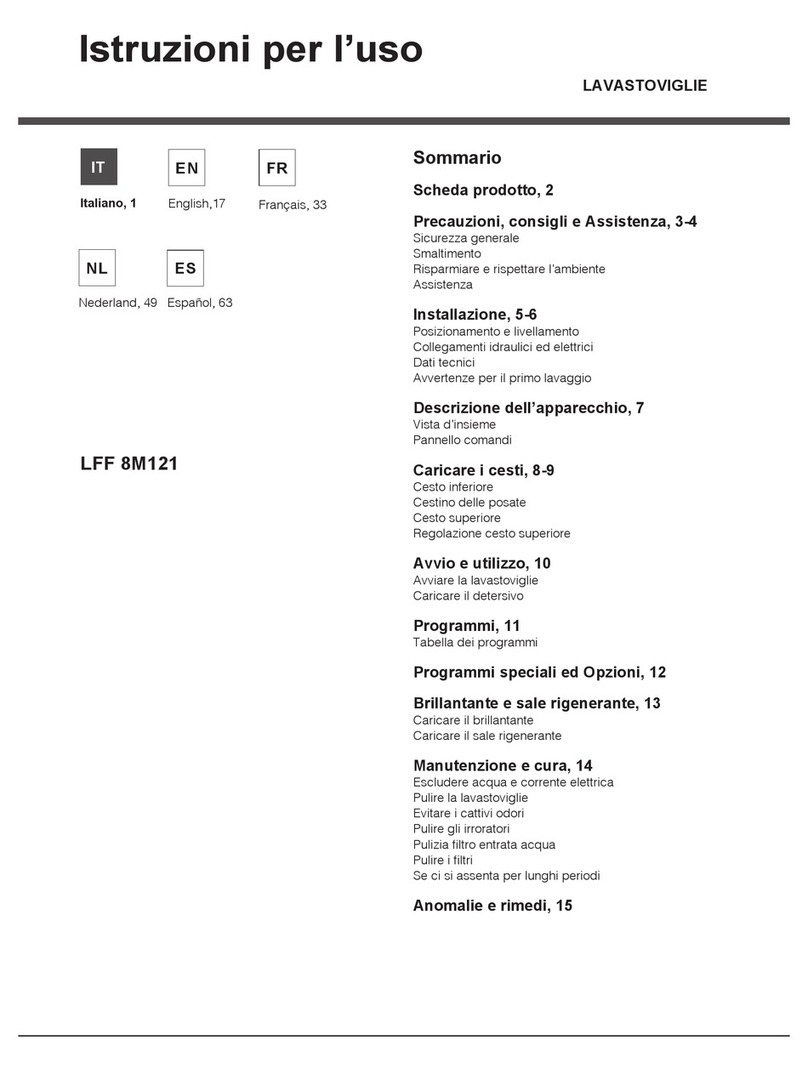
Hotpoint Ariston
Hotpoint Ariston LFF 8M121 operating instructions

Asko
Asko DBI664 operating instructions
